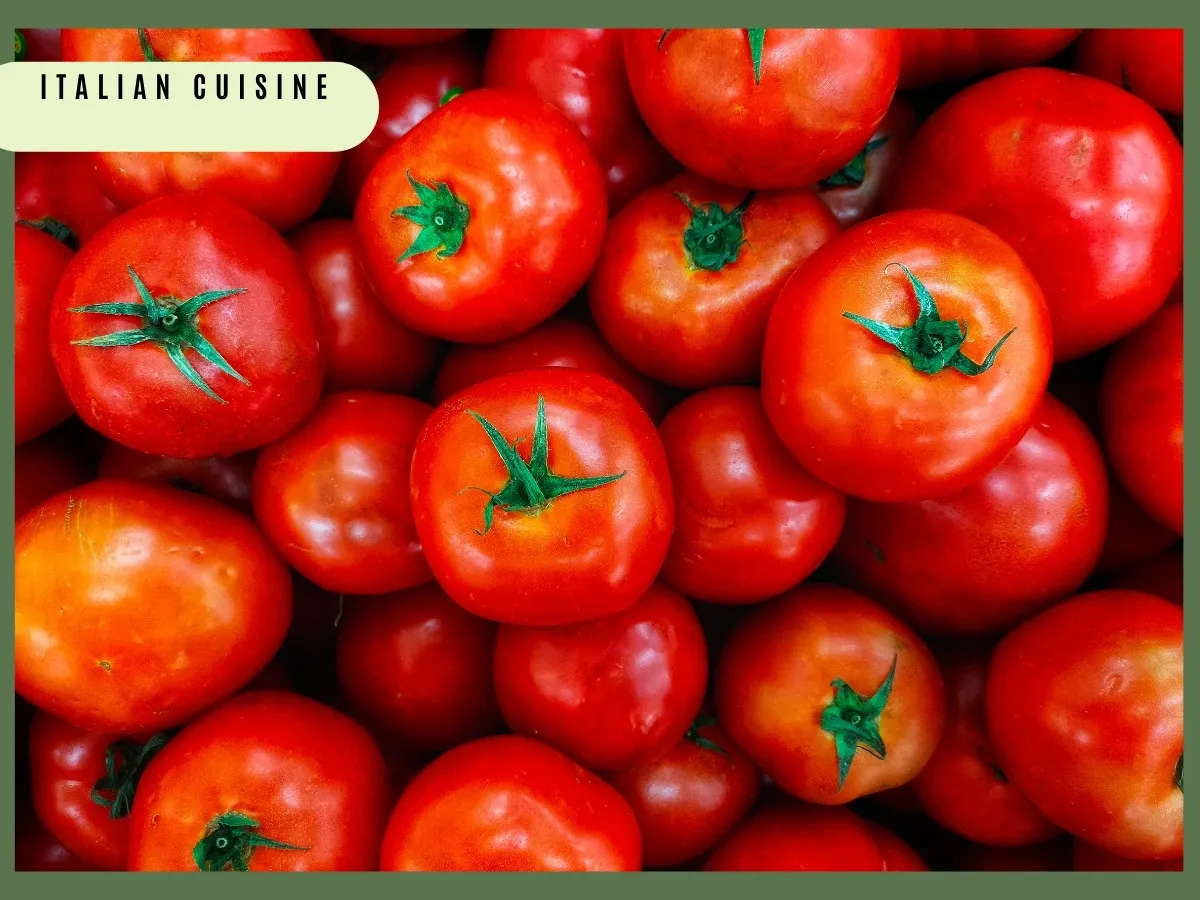Last updated on August 17th, 2025 at 08:49 am
The vibrant red hue, the juicy flesh, the burst of flavor – the Italian tomatoes is a sensory delight. Its versatility makes it a cornerstone ingredient in countless Italian dishes.
Tomatoes in Italy: Tomatoes are the reigning queen of the Italian table, but that hasn’t always been the case. Tomatoes aren’t native to Italy. They originally came from Central and South America, and the Spanish brought them to Europe in the 16th century. There are more than 10,000 tomato varieties. The tomato has prospered in Italy because of its near-tropical climate.
Italian Tomatoes: A Must-Have for Italian Meals
Are tomatoes a fruit or a vegetable?
A fruit’s botanical classification is that it’s formed from flowers, has seeds, and assists with the plant’s reproduction process. From that standpoint, the tomato ticks all the boxes. Culinary classification is another thing altogether. Regarding cooking, fruits and vegetables are classified primarily based on their flavor profile and how they are utilized in cuisine. Tomatoes are almost always used in savory dishes, so we consider them vegetables.
Italian Tomatoes – Impact on the Mediterranean Diet
The introduction of tomatoes has significantly impacted the evolution of Italian cuisine. Tomatoes are now a vital component of the Mediterranean diet, adding flavor and nutritional value to many traditional dishes.
With their high vitamin and mineral content, tomatoes have become an essential part of healthy eating in the Mediterranean region. They also add vibrant color to various meals, making them appealing and delicious.
Fresh Italian Tomatoes have revolutionized Italian cooking and influenced other Mediterranean cuisines, making them more prosperous and diverse.
Whether using San Marzano or cuore di bue varieties in different recipes, tomatoes are crucial in defining the essence of Italian cuisine and its impact on broader Mediterranean dietary practices.
Incorporating fresh produce like tomatoes has changed my understanding of traditional diets. It’s fascinating to see how this simple ingredient can significantly transform taste and health aspects within regional food cultures.
Italian Tomatoes: The Heart of Italian Cuisine – High in Vitamins and Minerals
As a food lover, it’s crucial to understand that tomatoes are high in essential vitamins and minerals, making them an invaluable addition to Italian cuisine. Tomatoes contain vitamin C, potassium, folate, and vitamin K.
Moreover, tomatoes are rich in antioxidants like lycopene, which are known for their potential health benefits, such as reducing the risk of certain chronic diseases. With these nutritional qualities in mind, tomatoes contribute to the vibrant flavors of Italian dishes and offer significant health advantages.
Busy foodies should note the abundance of nutrients found in tomatoes. By incorporating tomato-based dishes into their diets, they can easily access a range of vital vitamins and minerals that support overall health.
Tomatoes’ versatility means they can be included in various recipes—from refreshing salads to hearty pasta sauces. With their impressive nutrient profile and culinary adaptability, incorporating tomatoes into your cooking routine can elevate your meals’ flavor and nutritional content while promoting good health.
Italian Tomatoes: The secret ingredient of Italian culinary mastery.
Italy boasts a wide variety of tomato species, each contributing unique flavors and textures to Italian dishes. From the sweet and juicy San Marzano variety, perfect for sauces, to the small, tangy cherry tomatoes often used in salads, the diversity allows chefs to choose the best type for every dish. This rich variety enhances the authenticity and complexity of Italian cooking.
In Italy, the quality of the tomato is paramount. Freshly picked, sun-ripened tomatoes create remarkable depth of flavor in any dish. Italian chefs emphasize sourcing local, seasonal tomatoes, often from their own gardens or local markets, ensuring that each meal is a celebration of freshness. This devotion to quality helps elevate traditional recipes to new heights.
Tomatoes are the backbone of many iconic Italian sauces. Whether it’s a classic marinara, a rich bolognese, or a bright caponata, tomatoes provide the essential base that binds various flavors together. The natural acidity and sweetness of tomatoes balance the richness of meats, the Earthiness of vegetables, and the spice of herbs, creating harmonious, complex sauces that characterize Italian dishes.
Aside from their culinary appeal, tomatoes are also packed with health benefits. They are rich in vitamins A, C, K, and E, as well as minerals like potassium. Furthermore, tomatoes are known for their high content of antioxidants, particularly lycopene, which is linked to various health benefits, including heart health. This nutritional profile makes them a wholesome addition to any Italian dish.
Italian cuisine thrives on tradition, but tomatoes also allow for culinary innovation. Modern chefs experiment by incorporating tomatoes into unexpected dishes, such as tomato-based risottos or even tomato desserts, showcasing their versatility. This balance between adhering to classic techniques while exploring new ideas keeps Italian cooking dynamic and exciting.
The Italian culture has mastered the art of preserving tomatoes for year-round enjoyment. Techniques such as canning, drying, and making passata (pureed tomatoes) allow for the use of the vibrant flavor of tomatoes, even when they are out of season. These preserved tomato products ensure that classic Italian flavors remain accessible and vibrant throughout the year.
No two regions in Italy treat tomatoes the same; each area has its own signature tomato-based dishes. From the rich ragù of Emilia-Romagna to the refreshing caprese salad of Campania, tomatoes play a crucial role in defining the culinary identity of each Italian region. This regional diversity showcases how tomatoes are integral to the country’s cultural tapestry.
The Beauty of Italian Tomatoes – A Flavorful Source of Umami
Umami, often described as the fifth basic taste, is a savory, brothy flavor that enhances the overall taste of food. Tomatoes, particularly ripe, sun-kissed Italian varieties, are a fantastic source of umami.
Why Tomatoes Are So Umami-Rich
- Glutamic Acid: Tomatoes are naturally rich in glutamic acid, an amino acid that primarily contributes to umami flavor.
- Ripeness: As tomatoes ripen, the concentration of glutamic acid increases, leading to a more intense umami taste.
- Cooking Technique: Cooking tomatoes, especially in sauces or stews, intensifies their umami flavor.
How to Maximize Umami in Tomato-Based Dishes
- Use Ripe Tomatoes: Choose ripe, flavorful tomatoes for the best umami experience.
- Cook Slowly: Simmering tomatoes slowly allows the flavors to develop and intensify.
- Add Umami-Rich Ingredients: To boost the umami flavor, add mushrooms, soy sauce, or Parmesan cheese.
- Balance Acidity: A touch of acidity, such as lemon juice or vinegar, can enhance the umami taste.
By understanding the role of umami in tomatoes, you can create delicious and satisfying tomato-based dishes that will tantalize your taste buds.
Italian Dishes Featuring Tomatoes as the Star
Tomatoes (Italian tomatoes) are a cornerstone of Italian cuisine, adding flavor and vibrant color to countless dishes. Here are some iconic Italian dishes that highlight the versatility of tomatoes:
Classic Tomato-Based Sauces
- Sugo di Pomodoro: A simple yet flavorful sauce made with fresh tomatoes, garlic, olive oil, and basil.
- Ragù alla Bolognese: A rich, meaty sauce that is slow-cooked for hours to develop deep, complex flavors.
- Pesto alla Genovese: A vibrant green sauce made with basil, pine nuts, Parmesan cheese, garlic, and olive oil. While not strictly tomato-based, it often includes cherry tomatoes for a sweet, tangy flavor.
Pasta Dishes
- Spaghetti al Pomodoro: A classic Italian dish with pasta tossed in a simple tomato sauce.
- Pasta alla Norma: A Sicilian dish with eggplant, tomato sauce, ricotta salata, and basil.
- Spaghetti Carbonara: While not traditionally tomato-based, many modern variations incorporate tomatoes for a sweeter flavor profile.
Pizza
- Margherita Pizza: A classic Neapolitan pizza topped with tomato sauce, mozzarella cheese, and fresh basil.
- Pizza Napoletana: Another Neapolitan pizza that features San Marzano tomatoes, mozzarella di bufala, and fresh basil.
Other Dishes
- Caprese Salad: A simple yet elegant salad of tomatoes, mozzarella, and fresh basil drizzled with olive oil and balsamic vinegar.
- Bruschetta: Grilled bread topped with tomatoes, garlic, olive oil, and basil.
- Minestrone Soup: A hearty soup that often includes tomatoes as a key ingredient.
These are just a few examples of the many Italian dishes that rely on tomatoes as a primary ingredient.
The Secret Ingredient: Fresh Italian Tomatoes – The Italian influence on Argentine cuisine
Argentinian food is deeply influenced by its Italian heritage, as immigrants from Italy began arriving in Argentina in the late 19th and early 20th centuries. This fusion of culinary traditions has given rise to a vibrant food culture where dishes like pizza and pasta are not only popular but have been adapted to suit local tastes.
Cafés and restaurants across the country serve hearty pizzas topped with unique Argentine ingredients, while fresh pasta dishes often feature local flavors that marry traditional Italian techniques with Argentine flair. Gelato has become a beloved dessert option; many ice cream parlors boast flavors inspired by Italian recipes and regional fruits.
Despite the prevalence of red meat in Argentinian cuisine, often associated with the famous parrillas (steakhouses), introducing these Italian staples provides an appealing alternative for those seeking variety.
There are subtle differences between Argentinian and Italian foods, primarily based on ingredient availability; for instance, local cheeses or herbs might replace classic Italian components.
However, these alterations do not diminish the resemblance between the two cuisines but enrich them through a cultural exchange that reflects the family-style dining customs favored in both cultures.
Italian Tomato: A Flavorful Influence on Argentine Cuisine
While Argentina has unique culinary traditions, Italian immigration in the late 19th and early 20th centuries has significantly impacted its cuisine. Italian tomatoes, in particular, have become a staple ingredient in many Argentine dishes.
Pizza Fugazzetta: Argentine pizza with a thick crust, generous cheese, and tomato sauce.
Nutritional Value Of Green, Red, And Yellow Tomatoes
| Nutrient (per 100g) | Green Tomatoes | Red Tomatoes | Yellow Tomatoes |
|---|---|---|---|
| Calories | 23 kcal | 18 kcal | 15 kcal |
| Carbohydrates | 5.1 g | 3.9 g | 3.3 g |
| Protein | 1.2 g | 0.9 g | 0.9 g |
| Fat | 0.2 g | 0.2 g | 0.2 g |
| Fiber | 1.1 g | 1.2 g | 0.8 g |
| Vitamin C | 23 mg | 13.7 mg | 8.0 mg |
| Vitamin A (RAE) | 42 µg | 42 µg | 23 µg |
| Potassium | 200 mg | 237 mg | 212 mg |
| Lycopene | 0.5 mg | 3.0 mg | 0.2 mg |
| Beta-carotene | 540 µg | 449 µg | 100 µg |









